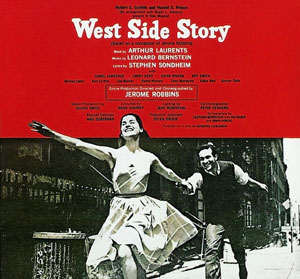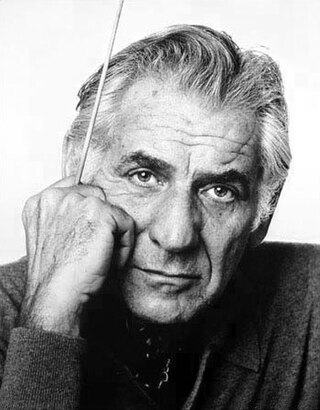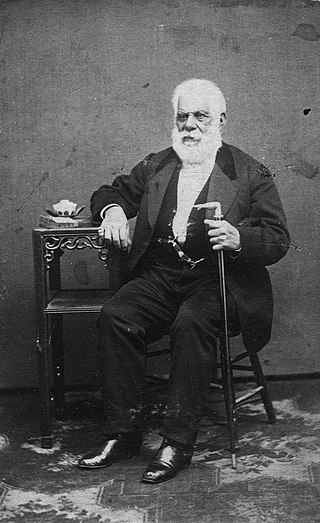
West Side Story is a musical conceived by Jerome Robbins with music by Leonard Bernstein, lyrics by Stephen Sondheim, and a book by Arthur Laurents.

Leonard Bernstein was an American conductor, composer, pianist, music educator, author, and humanitarian. Considered to be one of the most important conductors of his time, he was the first American-born conductor to receive international acclaim. Bernstein was "one of the most prodigiously talented and successful musicians in American history" according to music critic Donal Henahan. Bernstein's honors and accolades include seven Emmy Awards, two Tony Awards, and 16 Grammy Awards as well as an Academy Award nomination. He received the Kennedy Center Honor in 1981.

Elmer Bernstein was an American composer and conductor. In a career that spanned over five decades, he composed "some of the most recognizable and memorable themes in Hollywood history", including over 150 original film scores, as well as scores for nearly 80 television productions. For his work, he received an Academy Award for Thoroughly Modern Millie (1967) and Primetime Emmy Award. He also received seven Golden Globe Awards, five Grammy Awards, and two Tony Award nominations.

Samuel Ichiye Hayakawa was a Canadian-born American academic and politician of Japanese ancestry. A professor of English, he served as president of San Francisco State University and then as U.S. Senator from California from 1977 to 1983.
The Albert J. Beveridge Award is awarded by the American Historical Association (AHA) for the best English-language book on American history from 1492 to the present. It was established on a biennial basis in 1939 in memory of United States Senator Albert J. Beveridge (1862-1927) of Indiana, former secretary and longtime member of the Association, through a gift from his wife, Catherine Eddy Beveridge and donations from AHA members from his home state. The award has been given annually since 1945.

Crenshaw, or the Crenshaw District, is a neighborhood in South Los Angeles, California.

The California Alien Land Law of 1913 prohibited "aliens ineligible for citizenship" from owning agricultural land or possessing long-term leases over it, but permitted leases lasting up to three years. It affected the Chinese, Indian, Japanese, and Korean immigrant farmers in California. Implicitly, the law was primarily directed at the Japanese. It passed 35–2 in the State Senate and 72–3 in the State Assembly and was co-written by attorney Francis J. Heney and California state attorney general Ulysses S. Webb at the behest of Governor Hiram Johnson. Japan's Consul General Kametaro Iijima and lawyer Juichi Soyeda lobbied against the law. In a letter to the United States Secretary of State, the Japanese government via the Japanese Minister of Foreign Affairs called the law "essentially unfair and inconsistent... with the sentiments of amity and good neighborhood which have presided over the relations between the two countries," and noted that Japan felt it was "in disregard of the spirit of the existing treaty between Japan and the United States." The law was meant to discourage immigration from Asia, and to create an inhospitable climate for immigrants already living in California.

The California Eagle (1879–1964) was a newspaper in Los Angeles for African Americans. It was founded as The Owl in 1879 and later The Eagle by John J. Neimore. Charlotta Bass became owner of the paper after Neimore's death in 1912. She owned and operated the paper, renamed the California Eagle, until 1951. Her husband, J. B. Bass, served as editor until his death in 1934. In the 1920s, they increased circulation to 60,000. Bass was also active as a civil rights campaigner in Los Angeles, working to end segregation in jobs, housing and transportation.
Frank Bray Gibney was an American journalist, editor, writer and scholar. He learned Japanese while in the US Navy during World War II when it was stationed in Japan. As a journalist in Tokyo, he wrote Five Gentlemen of Japan, a popular book about the Japanese that was welcomed for its humanism and for transcending the bitterness of war. A half dozen more books followed on Japan and East Asia. He also wrote on communism in Europe. At the Encyclopædia Britannica, he directed translations. He was also the founder of the Pacific Basin Institute.
Eiichiro Azuma is a Japanese-born American historian, writer, and professor. He has served as a Professor of History and Asian American Studies at the University of Pennsylvania. The focus of his work is Japanese Americans in relationship to migration, Japanese colonialism, and U.S. and Japan relations.

Soul on Ice is a memoir and collection of essays by Eldridge Cleaver. Originally written in Folsom State Prison in 1965, and published three years later in 1968, it is Cleaver's best known writing and remains a seminal work in African-American literature. The treatises were first printed in the nationally-circulated monthly Ramparts and became widely read for their illustration and commentary on Black America. Throughout his narrative, Cleaver describes not only his transformation from a marijuana dealer and serial rapist into a convinced Malcolm X adherent and Marxist revolutionary, but also his analogous relationship to the politics of America.

There is a Japanese American and a Japanese national population in Los Angeles and Greater Los Angeles. Japanese people began arriving in the United States in the late 1800s and have settled in places like Hawaii, Alaska, and California. Los Angeles has become a hub for people of Japanese descent for generations in areas like Little Tokyo and Boyle Heights. As of 2017, Los Angeles has a Japanese and Japanese American population of around 110,000 people.

The history of African Americans in Los Angeles includes participation in the culture, education, and politics of the city of Los Angeles, California, United States.

New Worlds, New Lives: Globalization and People of Japanese Descent in the Americas and from Latin America in Japan (ISBN 978-0804744621) is a 2002 academic book edited by Lane Ryo Hirabayashi, James A. Hirabayashi, and Akemi Kikumura-Yano and published by the Stanford University Press. The volume, edited by three Japanese American anthropologists, was produced by the Japanese American National Museum's International Nikkei Research Project. The same project produced the Encyclopedia of Japanese Descendants in the Americas: An Illustrated History of the Nikkei, and the two books are companion volumes.

This is a bibliography of Los Angeles, California. It includes books specifically about the city and county of Los Angeles and more generally the Greater Los Angeles Area. The list includes both non-fiction and notable works of fiction that significantly relate to the region. The list does not include annual travel books, recipe books, and currently does not contain works about sports in the region.

Harry D. Harootunian is an Armenian-American historian of early modern and modern Japan with an interest in historical theory. He is Professor Emeritus of East Asian Studies, New York University, and Max Palevsky Professor of History and Civilizations, Emeritus, University of Chicago.
Gidra: The Monthly of the Asian American Experience, the self-proclaimed "voice of the Asian American movement," was a revolutionary monthly newspaper-magazine that ran from 1969 to 1974. It was started by a group of Asian American students at the University of California, Los Angeles as a platform to discuss Asian American interests on campus and later expanded to address the entire Los Angeles Asian American community. Sixty issues of Gidra were published during its primary run, as well as a 1990 anniversary issue and five issues between 2000 and 2001.

Looking Like the Enemy: Japanese Mexicans, the Mexican State, and US Hegemony, 1897-1945 is a 2014 non-fiction book by Jerry García, published by The University of Arizona Press. It discusses the treatment of Mexicans of Japanese descent and Japanese nationals in Mexico during World War II, as well as the overall history from 1897 to the war.

Transpacific Antiracism: Afro-Asian Solidarity in 20th-Century Black America, Japan, and Okinawa is a 2013 non-fiction book by Yuichiro Onishi, published by New York University Press. It details relations between African-Americans and Japanese people in civil rights issues.

Scott Kurashige is an interdisciplinary scholar of race and ethnic studies, currently serving as an adjunct instructor at the University of Washington. Prior to that, he was a Professor and Chair of Comparative Race and Ethnic Studies at Texas Christian University. He is author of The Shifting Grounds of Race: Black and Japanese Americans in the Making of Multiethnic Los Angeles (2008) and The Fifty-Year Rebellion: How the U.S. Political Crisis Began in Detroit (2017). With Grace Lee Boggs, he co-authored The Next American Revolution: Sustainable Activism for the Twenty-First Century (2011) and was also a co-author and co-editor of Exiled to Motown: A History of Japanese Americans in Detroit.
















